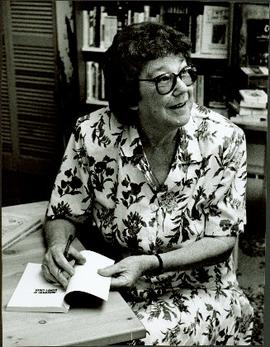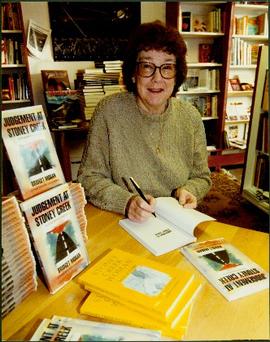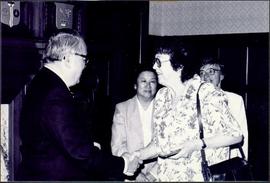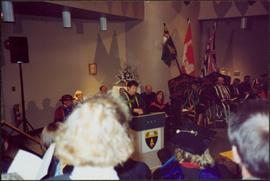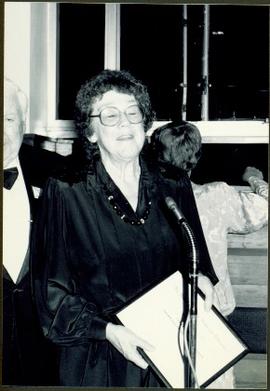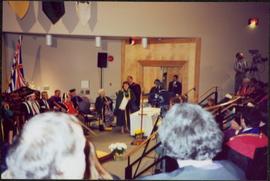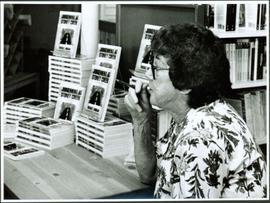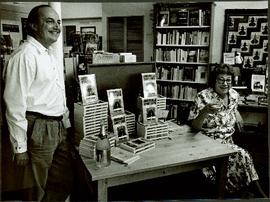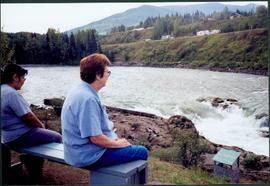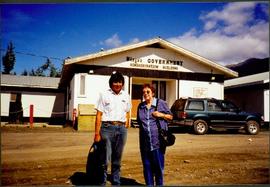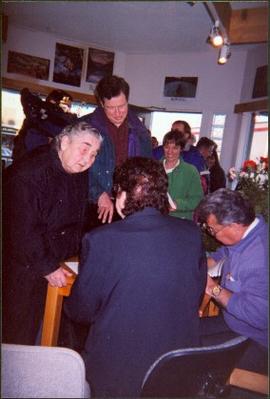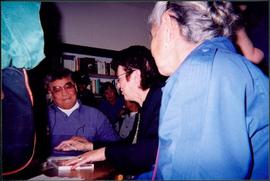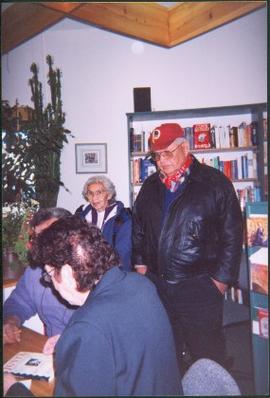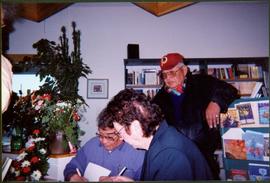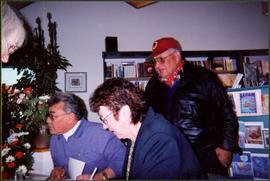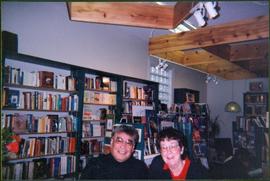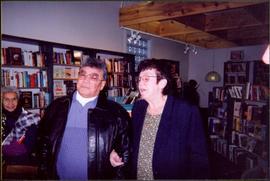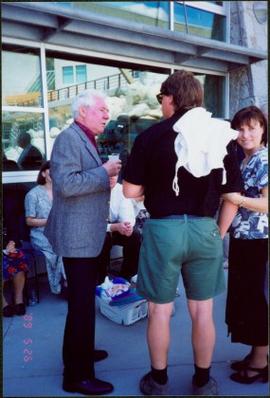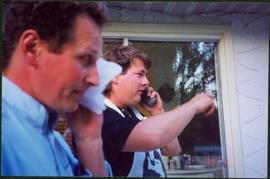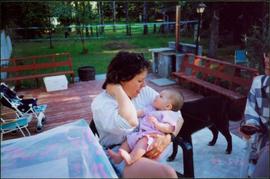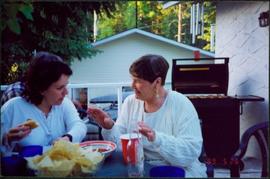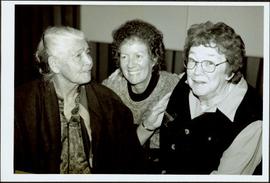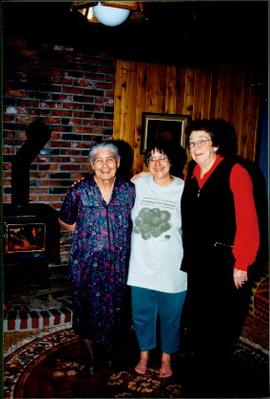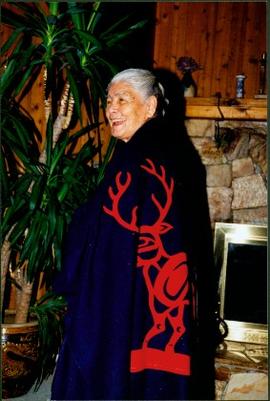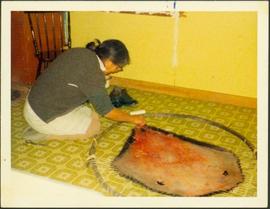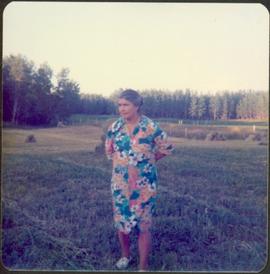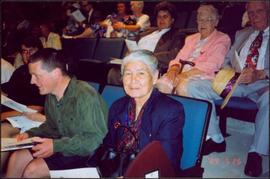File consists of newspapers (all dated 1976) include: The Citizen; and The Nechako Chronicle featuring articles on the Thomas inquest. File includes the Nechako Chronicle, vol.60, no.26, Thursday July 1, 1976.
File consists of Newspapers on the history of Vanderhoof, Fort St. James, Fort Fraser, etc.:
- Nechako Chronicle Historical Supplement: "Vanderhoof Village Incorporated 1936" (p.9 - 16) (April 2, 1970)
- Nechako Chronicle Historical Supplement: "Village of Fort St. James Incorporated December 1952" (p.25 - 30; 17-20) (April 2, 1970)
- Nechako Chronicle Historical Supplement: "Municipality of Fraser Lake Incorporated 1966" (p.41-44; 31-34) (April 2, 1970)
- Nechako Chronicle Historical Supplement: "Endako Mines Ltd. (N.P.L.)" (35-40) (April 2, 1970)
- Nechako Chronicle Historical Supplement: "1920-1970, 50 Year Review, The Nechako Chronicle" (p.1 - 8) (April 2, 1970).
File consists of:
- Newspaper clipping: "Gramma Mary's open house" by Bev Christensen (PLUS!, Feb. 9, 1991)
- Newspaper clipping: "Homes - Photographs" (PLUS!, Feb. 9, 1991)
- Newspaper clipping: Photocopy of "Homes," Mary John's home (PLUS!, Feb. 9, 1991)
- Newspaper clipping: Photograph of Justa Monk and Mary John, taken by Brent Braaten (Prince George Citizen)
- Newspaper clipping: "Stoney Creek elder honored at potlatch" by Bernice Trick (The Prince George Citizen, July 27, 1996)
- Newspaper clipping: "Stoney Creek Woman's story of courage crosses cultures" by Linda Bates (Vancouver Sun, Nov. 13, 1992)
- Newspaper clipping: "Stoney Creek Woman" (Prince George Pioneer, Feb. 22, 1994)
- Newspaper clipping: "Pioneer Profile: Bridget Moran" (Prince George Pioneer, Sept. 6, 1994)
- Newspaper clipping: Photocopy of "A visit with Stoney Creek Woman" by Adella Saul (Tseba, Newsletter for the First Nations Students at UNBC, March 27, 1995)
- Newspaper clipping: "Honorary degrees on agenda" (Prince George Citizen, April 22, 1996)
- UNBC spring convocation invitation for the gifting of honorary degrees
- Letter from The Order of Canada to Bridget Moran from Madeleine Proulx re: Mary John's nomination for the Order of Canada (May 30, 1996)
- Newspaper clipping: Photograph of Mary John (The Prince George Free Press, Jan. 16, 1996)
- Newspaper clipping: Elder Wisdom (The Prince George Free Press, Jan. 16, 1997)
- 2 colour photographs: Bridget Moran and Mary John having tea at The Empress Hotel in Victoria (Feb. 1997) and Bridget Moran and Mary John having tea at The Empress Hotel in Victoria - close-up (Feb. 1997)
- Newspaper clipping: "Elder shares lessons from Stoney Creek" (date unknown)
- 1 black and white photograph: Group photograph Mary John, Joanne Hope, and Bridget Moran (date unknown)
- Letter to Bridget Moran from Bob Harkins re: support for Mary John to receive an honorary degree from UNBC (Nov. 25, 1995)
- Fax from Elders Society Stoney Creek (Nov. 23, 1995)
- Newspaper clipping: "Book Review: Stoney Creek Woman" by Catherine Loull (The Womanist, date unknown)
- Newspaper clipping: "Who's reading what" (Prince George Free Press, June 1, 1997)
- Newspaper clipping: Photograph of Bridget Moran signing copies of her book, photo taken by David Mah (Prince George Citizen, Oct. 10, 1996)
- Newspaper clipping: "Local author plays role in celebrating woman's history" by Joan Jarman (Prince George This Week, Oct. 6, 1996)
- Invitation and photograph of Mary John receiving the Order of Canada
- Letter to Mary John from Rachael Donovan, PhD, Acting President, College of New Caledonia re: RSVP to a dinner celebrating Mary John's achievements (June 16, 1997).
File consists of:
- Name tag for Bridget Moran from Island Mountain Arts
- Pamphlet from Island Mountain Arts where Bridget Moran taught writing (Summer School 1995)
- Pamphlet from Island Mountain Arts where Bridget Moran taught writing (Wells, BC, 1997)
- Pamphlet: "A Weekend Of Creative Writing with Bridget Moran" (Nov. 22, 23, 24, 1996)
- Description of Bridget Moran's Creative Writing class from Island Mountain Arts (1995)
- Newsletter from the College of New Caledonia's Counseling and Advising News re: College of New Caledonia's Writing and New Media Technologies (date unknown)
- Newspaper clipping: "What A Mom!" by Bridget Moran (Prince George Citizen, May 7, 1997)
- Newspaper clipping: Photograph of Bridget Moran "Helping Hands/Pass it on" (The Prince George Free Press, May 4, 1997)
- Newspaper clipping: "Living History" (The Prince George Free Press, Oct. 9, 1997)
- Newspaper clipping: "Women's History special celebration" (The Prince George Free Press, Oct. 23, 1997)
- Newspaper clipping: Advertisement to meet Mary John and Bridget Moran (Oct. 4)
- Photocopy of advertisement to meet Mary John and Bridget Moran at Mosquito Books
- 2 Photographs of Stoney Creek Woman display in the front window of a book store featuring an article on Mary John's receipt of the Order of Canada
- Newspaper clipping: "Group formed to fight recall" by Don Schaffer (Prince George Citizen, Nov. 4, 1997)
- Newspaper clipping: "Book Fest is a first" (The Prince George Free Press, Oct. 30, 1997)
- Pamphlet: "A Writing Weekend Retreat with Bridget Moran" (April 11, 12, 13, 1997)
- A Note of Appreciation from the College of New Caledonia Social Services Foundations to Bridget Moran (Nov. 1997)
- Thank you letter to Bridget Moran from Julia Whittaker, Director/Curator of the Prince George Art Gallery (Dec. 5, 1997)
- Thank you card to Bridget Moran from Christine Jackman re" speaking to WRIT100 class (Nov. 1997)
- Newspaper clipping: "City author Moran picture of ambition pursuing her dream" by Bernice Trick (Prince George Citizen, Dec. 8, 1997)
- Pamphlet advertisement featuring Bridget Moran as a supporter of Paul Ramsey
- Newspaper clipping: Advertisement featuring Bridget Moran as a supporter of Paul Ramsey (Dec. 12, 1997)
- Christmas card thanking Bridget Moran (date unknown)
- Christmas tag to Bridget Moran from Mary Ellen (date unknown)
- Advertisement for Creative Writing taught by Bridget Moran for Island Mountain Arts
- Letter advertising Stoney Creek Woman (date and company unknown)
- Letter to Arsenal Pulp Press Book Publishers Ltd from Janice Henly re: making an audio tape of Stoney Creek Woman for disabled students at Kelly Road Secondary School (Jan 15, 1998)
- Newspaper clipping: Top Ten Non-Fiction Bestsellers in British Columbia (Vancouver Sun, Jan. 17, 1998)
- Newspaper clipping: "Bestsellers" (Jan. 21, 1998)
- Newspaper clipping: "Here's the buzz: Mosquito Books is bigger, brighter and better" (The Prince George Citizen, Oct. 30, 1997)
- Advertisement for Judgement at Stoney Creek from Arsenal Pulp Press
- Fax from Legal Service Society re: Bridget Moran's resignation from the Media Committee to the Native Programs Committee (Sept. 21, 1995)
- Newspaper clipping: Letters to the editor - "Native studies needed in our classrooms" by Bridget Moran (Oct. 27, 1998)
- Newspaper clipping: "Mary John in hospital after suffering stroke" by Mark Nielsen (date unknown)
- Newspaper clipping: "Board members and senior management visit communities" (June 1998)
- Newspaper clipping: advertisement for KPMG, Aboriginal Services Group, Justa Monk a member (date unknown)
- Newspaper clipping: "New judgement on old book" (The Prince George Free Press, Oct. 4, 1998).
File consists of:
- Newspaper clipping: "Horse radish in the corn flakes" by Bridget Moran (North Star, June 20, 1970)
- Newspaper clipping: "The dignity of humanity?" by Bridget Moran (North Star, June 23, 1970)
- Newspaper clipping: "frankly speaking" by Bridget Moran (North Star, July 15, 1970)
- Newspaper clipping: "A basic difference in attitude" by Bridget Moran (North Star, June 27, 1970)
- Newspaper clipping: "frankly speaking" by Bridget Moran (North Star, Sept. 9, 1970)
- Newspaper clipping: "frankly speaking" by Bridget Moran (North Star)
- Newspaper clipping: "frankly speaking" by Bridget Moran (North Star, Aug. 19, 1970)
- Newspaper clipping: "frankly speaking" by Bridget Moran (North Star, Sept. 23, 1970)
- Newspaper clipping: "frankly speaking" by Bridget Moran (North Star, Oct. 29, 1970)
- Newspaper clipping: "frankly speaking" by Bridget Moran (North Star, Oct. 22, 1970)
- Newspaper clipping: "Native History Neglected, Ridiculed" by Bridget Moran (New Leaf, June 1971)
- Newspaper clipping: "All About Welfare Bums" by Bridget Moran (New Leaf, August 1971)
- Newspaper clipping: "B.C. Has Its Own Style of a Disaster" by Bridget Moran (date unknown)
- Newspaper clipping: "The Reserve: Cradle or Coffin?" by Bridget Moran (The Citizen, Jan. 15, 1969)
- Newspaper clipping: "The Demise of The Geriatric Square" by Bridget Moran (The Citizen, Nov. 28, 1968)
- Newspaper clipping: "What is Your Preference: No Prejudice or No Food?" by Bridget Moran (date unknown)
- Newspaper clipping: "frankly speaking" by Bridget Moran (North Star, July 29, 1970)
- Handwritten letter to Allan Fotheringham (?) from Bridget Moran re: free-lance writing for the Vancouver Sun (date unknown)
- Handwritten notes by Bridget Moran re: Home Acquisition Grant and affordable housing (date unknown)
- Newspaper clipping: "Allan Fortheringham" (Vancouver Sun)
- Newspaper clipping: "frankly speaking" by Bridget Moran (North Star, Aug. 26, 1970)
- Newspaper clipping: "My Backbone Is Great And My Soul Is Rested" by Bridget Moran (Vancouver Sun, Mar. 11, 1967)
- Newspaper clipping: "Horse radish in the corn flakes" by Bridget Moran (North Star, June 20, 1970)
- Newspaper clipping: "Horse radish in the corn flakes" by Bridget Moran (North Star, June 20, 1970).
File consists of article clippings from the following newspapers: The Citizen; the National Post; The Free Press; the Vancouver Sun; The Province; and The Globe and Mail. File also includes the Memorial Service program: "A Celebration of the Life of Bridget Ann Moran, September 1, 1923 - August 21, 1999; CNC Atrium, Saturday, September 11, 1999; 2:00pm."
File consists of:
- "Bridget looks back into eye of storm" (The Citizen, Feb. 21, 1983)
- Invitation to a reception in honour of Mary John and Bridget Moran on the receipt of Governor General's Award for Community Service (April 3, 1993)
- "A Child's Christmas in Saskatchewan"
- "New Prince George jail can't solve old problem" (Current, October 1994)
- "The hardcore poor who defeat us in the poverty war" (Canadian Panorama, April 5, 1969)
- Laser copy of photograph taken at Mosquito Books, April 3, 1993: Lazare John, Brian Gardner, M.P., Mary John, Bridget Moran, Lois Boone, MLA, Chief Robert William (?), Theresa Monk, Justa Monk
- Address list: Council of CEO's (colleges)
- "B.C. Today" (vol.1, no.3, Jay 27-June 9, 1976)
- The Province newspaper, (Jan.10, 1976) pages 2-4; 9-12)
- "Watch out, Bill, Dave's gaining" (The Vancouver Sun, May 11, 1976)
- "Shot down: a chance for the homeless poor" (The Vancouver Sun, Oct. 2, 1971)
- "Don't call them poor, just broke" (The Vancouver Sun, Aug.1, 1968)
- "Manslaughter, then Justa for all" and "Blanket coverage" (B.C. Bookworld, Spring 1995)
- 3 Photographs: "Justa Monk, John Alexis (Tachie Village) and the Premier [Mike Harcourt] taken in Prince George B.C. Jan.23/95 "the day Kemano 2 was killed"; Mary John and Bridget Moran at a books signing for "Stoney Creek Woman"; Unidentified woman, Mary John and Bridget Moran at a books signing for "Stoney Creek Woman"
- News Release: "Community better represented on Legal Services Board" featuring appointment of Bridget Moran to the LSS (Feb. 3, 1995)
- Copy of letter to Bridget Moran from Geoffrey R. Weller re: bestowal of UNBC honourary degree, Doctorate of Laws (Jan. 30, 1995)
- "Bridget still making history" (The Citizen, Jan.20, 1989)
- Letter to Bridget Moran from June Huggins-Clark, Chief Librarian, Prince George Public Library re: Bridget's receipt of Jeanne Clarke Award. (Jan.24, 1989)
- Letter to Bridget Moran from Naomi Miller, Competition Chairman for the B.C. Historical Federation re: thanking Ms. Moran for her submission of Stoney Creek Woman to their competition (Jan.16, 1989)
- Advertisement for books signing by Mary John and Bridget Moran at Mosquito Books
- Letter from Pulp Press Book Publishers Ltd. to Bridget Moran noting publications to which reviews of Stoney Creek Woman were sent (Jan.16, 1989)
- Biography of Justa Monk written by Bridget Moran
- Bookmarks featuring: Stoney Creek Woman, Little Rebellion and Judgement at Stoney Creek.
File consists of the manuscript "My Old Flame" with a Note from Bridget at the beginning, another manuscript of "My Old Flame," and "The grief of giving up my long-time comfort" (The Vancouver Sun, Feb.22, 1992).
Audio recording is of an interview that Bridget Moran conducts with a Mrs. Thompson held in Success, Saskatchewan. Mrs. Thompson talks about municipal politics in the rural town of Success, Saskatchewan when Jimmie (her husband?) was on the Council. Most of the interview relates to Mrs. Thompson’s account of the marital and domestic life Alfie (Guy?) who was another town councilor and known as a local poet.
Audiocassette Summary
Side 1
00’05” Moran asks Mrs. Thompson about the time that Jimmie (her husband?) was on the Council in Success. She recalls when her husband joined the Municipal Council and notes it was for 6-7 years; c.1960s. Bridget asks her to explain the conflict between Jimmie and Alfie (Guy?) who was also on the Success Municipal Council. Bridget refers to Alfie and how he wrote books of poetry.
04’00” Mrs. Thompson recalls Jimmie joining the Council at the time of the municipal conflict about the selling of the Sports ground and that was the time that Colleen [?] also joined the Council. Mrs. Thompson recalls getting involved in the dispute and that she encouraged the community’s women to vote on the issue of this, as well as the assessment role and taxation dispute. Notes that the town was divided “into two camps” on the issue. Also talks about the other issues that Jimmie became involved in including need to better roads in the town.
14’00” Bridget asks her about Alfie and him being a poet. Mrs. Thompson talks about Alfie returning to town after World War II and about his relationship with his first wife Lil. They eventually divorce and he remarried three more times. Most of this section is about his relationship with his second wife.
25’00” Mrs. Thompson notes that Alfie is still alive and is in his 80’s and still writes poetry. She recounts one poem he wrote entitled ‘Town of Purple Gas’ and provides an account of how he was inspired to write this – someone in town was putting an unknown substance in the gas that turned it purple… Bridget notes he was ‘quite the character.’
End of Tape
Photograph depicts Bridget Moran seated at table with copy of her book in hand. Bookshelves visible in background.
Photograph depicts Bridget Moran seated at table covered with copies of 'Judgement at Stoney Creek'. Three copies of 'Stoney Creek Woman' are also displayed on table. Bookshelves in background. Photo believed to have been taken at same location as items 2008.3.1.17.1, 2008.3.1.17.2, and 2008.3.1.19.4.
Handwritten annotation on recto: "Bridget Moran receives the Lieutenant - Governor's Medal for Historical Writing from His Honour David C. Lam in Government House, May 12, 1989." Lieutenant Governor Lam stands in formal attire on left, shaking hands with Moran. Two woman stand in background.
Photograph depicts Moran wearing regalia and standing at podium while reading at the University of Northern British Columbia in Prince George, B.C. Group sits in foreground and background. Flags and speakers can be seen against far wall.
Handwritten annotation on recto: "Bridget Moran thanks the B.C. Historical Federation for recognizing her as best author of 1988." Moran stands behind microphone, holding award. Don Sale and Naomi Miller of the B.C. Historical Federation Writing Competition Committee stand in background.
Photograph depicts Moran wearing regalia and holding an unidentified item in the Canfor lecture theater at the University of Northern British Columbia in Prince George, B.C. Group sits against wall in foreground and in theater seats in background. Flags and speakers can be seen against far wall. Cameras and photographers also visible in image.
Photograph depicts Bridget Moran seated at table covered with copies of her book.
Photograph depicts Bridget Moran seated at table covered with copies of her book. Unidentified man stands on left, bookshelves visible in background.
Photograph depicts Moran seated to right of woman on bench in foreground. Waterfall area at Moricetown Canyon can be seen below, behind booth labeled "MONITER BOOTH". Highway and houses visible on opposite shore in background.
Photograph depicts Bridget Moran standing beside unidentified man in front of white building with the sign "Nisga'a Government Administration building". Suburban parked in front of building, trees and mountains visible in background.
Photograph depicts Justa Monk and Bridget Moran seated at table, signing copies of 'Justa: a First Nations Leader'. The pair faces crowd standing in background. Windows and posters visible behind crowd.
Photograph depicts Justa Monk and Bridget Moran seated at table, signing copies of 'Justa: a First Nations Leader'. Crowd stands gathered around.
Photograph depicts Justa Monk and Bridget Moran seated at table, signing copies of 'Justa: a First Nations Leader'. Plants, bookshelves, and two unidentified individuals in background.
Photograph depicts Justa Monk and Bridget Moran seated at table, signing copies of 'Justa: a First Nations Leader'. Plants, bookshelves, and unidentified man visible in background.
Photograph depicts Justa Monk and Bridget Moran seated at table, signing copies of 'Justa: a First Nations Leader'. Plants, bookshelves, two unidentified individuals also visible in image.
Photograph depicts Justa Monk and Bridget Moran seated in bookstore, bookshelves in background.
Photograph depicts Justa Monk and Bridget Moran standing in bookstore. Unidentified woman and bookshelves in background.
File consists of a speech (?) / manuscript (?) / Open Letter (?) written by Bridget Moran re: trip to Moscow and planning for the World Congress of Peace Forces (Nov.1973) and a speech (?) / manuscript (?) / Open Letter (?) written by Bridget Moran re: trip to Cuba.
File consists of:
- Letter from Charlene Wyse, on behalf of the Hilye'yu Lelum Society, to Bridget Moran, January 27, 1995
- Transcript of "Harkins Comment" by Bob Harkins which features both Mary John and Bridget Moran (April 5, 1993)
- Copy of open letter from Brian Lam, Managing Editor, Arsenal Pulp Press regarding Bridget Moran's publications and Mary John's story (April 2, 1993)
- Two draft versions of eulogy for Bridget Moran for her memorial service at the College of New Caledonia, September 12, 1999.
- "We Three"- poem written in memory of a trip taken by Bridget and her daughters Mayo and Roseanne in 1994.
- One original draft and one copy of "A Minority of One" by Bridget Moran (26 pages)
- One original and signed draft letter to Dave [?] from Bridget Moran discussing the social welfare situation in the province and offering a plea for dialogue with the intended recipient.
- Letter from John H. Wood, administrative officer for the Leader of the Opposition to Bridget Moran in answer to a number of questions routed to this office via Dave [?] (August 10, 1972)
- Letter from Norman Levi, Minister of Rehabilitation and Social Improvement to Bridget Moran in answer to her letter dated October 18, 1972. (October 23, 1972)
- Copy of letter from Bridget Moran on behalf of the Greater Vancouver Area Branch of the BC Association of Social Workers to Minister Norman Levi in follow-up to a previously submitted questionnaire. (October 18, 1972).
- Letter to Bridget Moran from Rosemary Brown, M.L.A. acknowledging her receipt of an article previously sent to Ms. Brown by Ms. Moran. (October 9, 1973)
- Newspaper clippings regarding Moran's various appointments in Prince George.
- Various published stories written by Bridget Drugan in her youth: "How to Spend a Drizzly Day"; "How She Spent November 5"; "Camping Trip"; Story contest submission and announcement of winners.
- Torchbearer's Club "Carry On" certificate recognizing the printing of one of Bridget's stories. (September 10, 1938).
File consists of:
- Letter from Teresa Saunders, SFU Program Coordinator, to Bridget Moran re: request for speaking engagement with SFU students. (Dec.19, 1997)
- Note from Sandy, of the BC Festival of the Arts (1998) includes brochures on "Otherwords '98" Festival Writing Competition
- Copy of letter from Bruce Allen, Dakelh Program and First Nations Studies Instructor, College of New Caledonia to Honours and Awards Secretariat re: support for Justa Monk's receipt of Order of British Columbia (Feb. 5, 1998)
- Letter from Alternative Continuing Education, Hazelton Secondary School to Bridget Moran re: invitation to Bridget Moran and Mary John to speak on Stoney Creek Woman (Sept.18, 1996)
- Brochure: J.M. & Associates First Nations Consulting Group.
File consists of:
- Manuscript: "Welfare and the Good Life" by Bridget Moran
- "Out of tune" (The Sun)
- "Should be 'Darned Pleased'" by Mrs. C.G. Maxwell of Prince George
- "Mrs. Moran wins race for 1959 baby"
- "Simon Fraser music considered unsuitable"
- "Exciting years vividly remembered" by J. Crooks of Prince George
- "Letters to the Editor: Mrs. Moran replies to her critics"
- "My backbone is great and my soul is rested" (The Vancouver Sun, March 11, 1967)
- "Social register causes no stir"
- "Don't call them poor, just broke" (The Vancouver Sun, Aug.1, 1968)
- Manuscript: "The Decline and Fall of Mr. Sullivan" by Bridget Moran
- Manuscript: "Unholy Deadlock" by Bridget Moran
- Typewritten draft with handwritten annotations: "Case History of a Gadfly" by Bridget Moran
- Handwritten note to Roseanne [Moran] from Bridget Moran re: copy of short story; manuscript: "Man Alive"
- "Women and welfare"
- "Campfire club song" lyrics written by D. Watson and B.A. [Bridget] Moran
- Notebook, dated April 12, 1951, containing research notes from various publications
- Speech (?) / Manuscript (?) / Open Letter (?) written by Bridget Moran re: trip to Moscow and planning for the World Congress of Peace Forces (Nov.1973).
File consists of a telegram to Wally du Temple from Bridget and Pat Moran (Feb. 13, 1964); a letter sent to Bridget Moran from Wally du Temple re: assistance in conducting research for A Little Rebellion; a newspaper article: "Brothers paddled into the jaws of hell" (Victoria Daily Times, Oct. 23, 1969); resume and work record of Wally G. du Temple [RESTRICTED]; newspaper article: "Former welfare man off to Aklavik in river boat."
Photograph depicts group of three standing in Agora courtyard at the University of Northern British Columbia in Prince George, B.C. Unidentified individuals sit in background. Accompanying note from Maureen Faulkner: "Mike, Tracy & Pat - we're having cookies & juice." Photo taken on the day Bridget Moran received an Honourary Law Degree.
Photograph depicts Bridget Moran's son Mike speaking on telephone in backyard, man named Mike in foreground. House in background. Accompanying note from Maureen Faulkner: "Mayo on the phone to Mike. Dave looks like he's got an onion in his eye." Photo taken on the day Bridget Moran received an Honourary Law Degree from the University of Northern British Columbia in Prince George, B.C.
File consists of Memorandum of Agreement between Mary John, and Bridget Moran re: the publication and distribution of potential royalties from the future publication of "Mary and Me" (Oct. 20, 1998).
Photograph depicts Maureen Faulkner holding baby named Caitlin on deck in backyard. Bridget Moran's daughter Roseanne sits on far right, beside black dog. Forest and fence visible in background. Accompanying note from Faulkner: "Me, batting bugs & chatting to Caitlin. A lovely wee girl." Photo taken on the day Moran received an Honourary Law Degree from the University of Northern British Columbia in Prince George, B.C.
Photograph depicts Maureen Faulkner seated to left of woman at table set with food and beverages on deck in backyard. Barbeque, trees and building visible in background. Photo taken on the day Bridget Moran received an Honourary Law Degree from the University of Northern British Columbia in Prince George, B.C.
File consists of:
- Liberating Our Children, Liberating Our Nations. Report of the Aboriginal Committee, Community Panel, Family and Children's Services Legislation Review in British Columbia, October 1992. Includes handwritten note from Dianne de Chamelan (?) to Bridget Moran and the following photocopies pages from this publication: 5-23 and 123-125.
- Addressed envelope from R. [Roseanne?] Moran to Bridget Moran containing copy of "Address from the Bar of the House" - Joe Gosnell speaking to the Nisga'a Treaty
- "The Rights of the Metis in British Columbia" (revised March 1998) published by Native Programs, Legal Services Society.
- Copy of article: "Native Indians seek resolution over issue of adopted children" by Rick Ouston for the Vancouver Sun, reprinted in Today's News (July 9, 1997)
- Newspaper clipping from The Province (Feb. 4, 1998) Pamphlet: T8TA [Treaty 8 Tribal Association] Education Department
- "Treaty 8 Tribal Association Member Community Profiles Including: 1. A Brief history of First Nation Communities in Northeastern B.C." Prepared by Kathlean Fitpatrick Research Services fro T8TA, Treaty and Aboriginal Rights Research Program, Sept. 1997.
- Fax from Lucette Kirbach to LSS Board of Directors (incl. Bridget Moran) re: Delgam Uukw (June 25, 1998)
- "A guide to Aboriginal organizations and services in British Columbia"
- "A Review of legal services to Aboriginal people in British Columbia" by Marion R. Buller (Feb. 7, 1994)
- Northeast Distribution [contact] List
- Catalogue: Books about First Nations and Aboriginal Peoples from Canadian Publishers
- "Fishing - Aboriginal Rights in British Columbia" (revised 1998) published by Native Programs, Legal Services Society.
- Photocopy of article "Why Canada has a moral obligation to abused Indians" by Grand Chief Edward John (The Vancouver Sun, April 3, 1996).
File consists of a newspaper article: "Farm mishap kills doctor" (June 21, 1989).
File consists of:
- Misc. handwritten notes re: public policy and numbers
- Handwritten table comparing social work case loads in 1945, 1951, 1961, 1964, 1970
- Handwritten notes re: social work case loads in 1945
- Handwritten table "Who Gets What" re: areas of government expenditure
- Letter to Mrs. Kris Robinson from Norman Levi, Minister of Rehabilitation and Social Improvement (March 28, 1973)
- Fax sent to Jacqui Bobenic, Ministerial Assistant to Hon. Joan Smallwood, Minitery of Social Services Victoria from Bridget Moran re: request for information.
- Faxes from Rosemary McCullough at the Ministry of Social Services re: staffing for fiscal year 1991/92; FTE increase in basic field structure (April 27, 1992)
- Prince George Public Library microform photocopying order form submitted by Bridget Moran for copies from the Prince George Citizen newspaper (Nov. 28, 1991) and the following newspaper clippings: "Welfare children beaten but court action not impending" (Jan. 21, 1957); Letter to the Editor: "Shocked" (Jan. 24, 1957); "Welfare branch may charge former foster parents here" (Jan. 28, 1957); Out of the Mail Bag: "The Welfare Reply" (Jan. 28, 1957); "Foster parent trial delayed" (April 18, 1957)
- Prince George Public Library microform photocopying order form submitted by Bridget Moran for copies from the Prince George Citizen newspaper (Dec. 2, 1991) and the following newspaper clippings: "Couple charged after infant seized in cache" (April 26, 1960); "Woman charged with murder" (Aug. 15, 1960); "City woman gets another remand on murder charge" (Aug. 29, 1960); "$5,000 bail granted Mrs. Dorothy Tosoff" (Sept. 22, 1960); "Tosoff hearing opens in court here today" (Oct. 6, 1960); "Mrs. Tosoff freed of murder charge" (Oct. 7, 1960); "Malnutrition case opens" (Oct. 25, 1960); "Couple convicted of starving child" (Oct. 26, 1960); "Wades get jail - 1 and 2 years - for child neglect" (Oct. 31, 1960)
- Copy of letter written to Hon. Ray Williston from Bridget Moran (Feb. 12, 1964).
Close view of three women at unidentified location. Left to right: John, Hope, Moran.
Unidentified woman stands between Mary John (on left) and Bridget Moran. Fireplace in background.
Photograph depicts Mary John wearing long blue material with red caribou in traditional artwork on back. Plant and ornamented fireplace in background. Photo speculated to have been taken in Mary John's home.
Audio recording consists of an interview conducted by Bridget Moran with Mary John.
Audiocassette Summary
Context: Recording is the continuation of earlier sessions by Bridget and Mary John talking about her life – appears to continue on from the other tape sessions numbered to #8 [Accession # 2008.3.1.211.4]
Side 1: “Mary John #9”
0’05” Bridget interviews Mary John and asks about Mary John’s grandmother who lived at the reserve at Fort George. Mary notes that her grandmother was sent back to Fort George and then to Stoney Creek after husband died. Her Grandmother remarried; she died in the 1950s. Mary talks about her grandmother’s marriage with Za (Jean) Paul – that was not an arranged marriage; her Grandmother “she had a hard life”
4’00” – 7’30” Mary Johns’ mother married Johnny Paul – not arranged; Mary notes that she was born in Fort George. Mary lived with her Grandmother Ann on reserve in Fort George. Mary then talks about her sister Bella – who married Mike Ketlo (sp?) and their children. She died of tuberculosis in the 1950s.
7’40” Bridget asks about the Mission School in Fort St. James – near the church “that is on Mission land” Which is where the village originally started. They talk about the church’s history briefly.
9’00”-14’00” Bridget asks Mary about her schooling at Lejac – Mary says they had reading, writing, arithmetic, penmanship and history. There was no science taught. Mary then describes the routine at Lejac. Doing chores and then breakfast at about 7:30 and then did cleaning chores in the dormitories. Then they attended their classes; then lunch, then played outside and then came back for sewing or embroidery, knitting and then back in classes until 4:00pm. Mary describes recreation – swimming, playing in the field, chores – pulling roots/stumps etc. Bridget talks about Joanne (Fiske?) thesis on the distinction between native boys and native girls’ activities and education at the residential school and that it enabled them to go to work in the hospitals and offices but that the farming education that was taught to the boys didn’t help them as there was no agriculture on the reserves. Mary notes she was ‘teachers pet’ as she had music lessons for singing. Mary notes she didn’t do anything in the kitchen but took mail to the post office and looking after the office for the Mother Superior. She feels she learned ‘the basics’ [but] then they ‘kicked you out at 16’
15’00” Bridget asks about the differences in disciplining methods of children – she notes that it is not part of Indian culture to spank children. She notes it is part of her husband’s sisters to discipline her children – not her or her husband’s duty
17’00” Mary talks about the residents at Stoney Creek who objected to school at Lejac because of harsh disciplinary methods used with their children
18’00” Mary talks briefly about the food at Lejac and speaks briefly to another unidentified woman [Sabrina?] in the room about food preparation [canning?]
19’50” Bridget asks about the Stoney Creek residents who wanted to have a school at the village in the 1950s and wanted their children to go to school there.
20’00” Mary speaks briefly about Father Coccola and that he did the negotiation about the move of the people from the reserve at Fort George to Shelley and about some compensation acquired by the residents. Bridget notes he ‘did not do a favour to the Indians’ – Mary notes that they were forced to leave ‘very illegal’
22’00” Mary speaks again about Father Coccola who could be ‘a very strict man’ but who took care of the people when they were sick and dying
23’00” Mary talks about another priest (unidentified) that she really liked who gave her a job c.1935 when she and her husband cleared land for Lejac and the priest treated them really well. She thinks he was from the Yukon as he had gold nuggets
25’00” Mary talks about her children going to Lejac in the 1950’s
26’00” Bridget talks about a social worker who came to Stoney Creek in c.1955 and Bridget was asked to come out by the Indian Agent to investigate what was the issue. This social worker was scared of being on the reserve; Mary thinks this woman had marital problems and drank a lot
28’00” Mary talks about the Day school operating c.1951 for a short time and the kids were bussed back and forth; other kids ‘orphans’ went to Lejac (lived there)
Tape is poor after this; noise with squeals and recording is faster
29’00” Mary talks about her children (Helen and the boys) not liking Lejac. She notes that one of the boys didn’t like it ‘but didn’t complain’ about it. She notes that ‘no one would talk about it’ “the whole village would be silent” when they left; and the children would be crying.
30’00”-33’00” Bridget asks Mary to discuss her wedding in more detail – Bridget notes that she already has on tape about the wedding night itself but asks for more information about the wedding day. Mary begins to talk about the wedding; there was a Mass, the guests and there was a band….
Tape is unintelligible after this; recording is broken up with interference and then there is no recording End of side 1
Side 2 “Mary John #10”
This side of the cassette has no recording
Audio recording consists of an interview conducted by Bridget Moran with Mary John.
Audiocassette Summary
Side 1
0’02” Improvements within the Department of Indian Affairs; she notes that Indian Affairs was tricking the band. The Indian Agent took a logging contract away from Mary John’s son Ernie because he refused to pay the rate that they wanted in stumpage fees
4’00” Mary John recalls when the community started to speak up against Department of Indian Affairs about 1942. She recalls the Elders Society and the Indian Homemakers Association. She explains that the Elders Society supports the preservation of the Indian culture and arts/crafts; which involves set up of activities including summer camps; showing youths how to use fishing and hunting tools and recreation tools. Bridget asks about Elders involved in the Society.
13’00” Mary talks about teaching Indian language at the school for the youths and also teaching previously in the village for the children yet none of the children continue to speak their language today. But now with parents speaking at home it’s difficult to have them continue to speak their language
16’00” Bridget asks Mary to recall the time when she was named Citizen of the Year in Vanderhoof in 1978. Mary shows Bridget the award and recalls that they ‘had a big dinner’ for her. Mary notes it was a surprise, Mrs. Campbell brought her there – Mary John recalls that she didn’t have a speech planned
19’00” Bridget asks her to explain about the tanning of hides. Mary explains the process from the time of the shooting of the moose; fleshing and scraping of the hide. She explains how to use the knife on the hide so you can see the tissues of the skin. Then Mary turns over the hide to the hair side and shaves off the hair on the hide and then shows Bridget how it is scraped. They discuss the blade and how it is sharp. She explains it is then washed many times to clean the blood off and then it is stretched. She explains it is then spread with oil/ possibly fish oil – the whole hide is oiled up and then left about a week to dry. Then once dry you use another scraper to ensure it is soft. She notes it is a lot of hard work and time to complete. They then talk about smoking of the hides and Mary shows Bridget hides that she had made herself. Mary explains that the Elders have a class for the youths to show them how to tan hides.
29’00” Bridget asks Mary about the last potlatch held. Mary explains what a potlatch is and when it is viewed as a pay-out. A potlatch is thrown to pay back another clan for a service or a kindness that was done to them. She talks about potlatches for deceased persons; and how clans host potlatches. She talks about the foods prepared at a potlatch. Mary recalls “it can cost thousands of dollars” and notes plans in progress for the next potlatch to be held in August in Stoney Creek.
36’00” Recalls when potlatches were made illegal – recalls gifts she received years before at potlatches and ‘that someone benefits from it’ Years ago hides and dried goods were given out. Potlatches started up again in about 1934 and they held a potlatch for her mother when she died.
40’00” Mary explains there are two clans at Stoney Creek – the Frog and the Grouse; she explains that you don’t marry within your own clan.
45’00” Recalls the death of some of her relatives
End of Side 1
Side 2
45’02” Mary talks about her siblings who are still alive
48’00” Talks about the preparation and setting of nets in canoes for fishing
52’00” notes people like to be called native – not Indian
52’30” Bridget asks Mary what she thinks that has changed that is good? She thinks that the good things are better homes, electricity, cars, education, transportation and better roads. She fears there isn’t as much closeness as there was years ago among families – now people sit at home and watch TV. “People use to do things together – they don’t anymore.” Mary points out that another good thing is that people now get pensions.
56’00 Mary John speaks about her sewing business that she now has and the making of mukluks and moccasins
57’00 Bridget recalls bringing her Mother to Stoney Creek Reserve c.1954 and her mother noting her poor life in Ireland and recalling the poor people she saw on the reserve at that time and telling Bridget she had to help those people
59’00 they both refer to poor services done by the Department of Indian Affairs in the 1950s
End of tape
Audio recording consists of an interview conducted by Bridget Moran with Mary John.
Audiocassette Summary
Scope and Content: Tape recording is an interview between Bridget Moran and Mary John – a continuation of interviews.
Side 1
0’02” Bridget asks Mary when she quit smoking - in 1972
1’00” Mary notes there was no talk of sex life; not part of First Nations culture
2’00” Mary talks about when she started working at the hospital; she was able to save money and her husband drove her back and forth; lived in a tent to save money; they pumped water to drink from a well 1 mile away so that they did not get sick; she notes she began working at hospital after her husband lost his seasonal job
5’00” Mary notes they had to have a tribunal hearing to get old age pension for her husband because his birth was not registered
7’00” Mary recalls that the Depression did not hit reserves as hard as white people because ‘they had always been poor’; yet at that time they were never without food. She talks about tough times during the Depression – could not find work only relief; got used clothing from white people
10’00” Mary refers to a Mrs. Campbell, a white woman who was a widow and had small children who was also poor in the Depression and showed her how to repair socks
12’00” She notes that they did not have much of a relationship with the Indian Agent – they knew he existed but they did not see him much; viewed him as a representative for the Indians; some [of the Indian Agents] were good and some were bad; she describes difficulties with the Indian Agent and getting little food: only a single ration (24 bag of flour; 5 lb bag of rice, bag of salt; ½ lb tea and 2 lbs lard) to last a family for a month and also flannelette material to make bed clothes. Indian Agent Office was in Vanderhoof
17’00” Mary recalls that the watchmen quit in the 40s – that is when marriages stopped being arranged; there were no Band Managers then; that only ‘started recently’
19’00” Mary talks about the priest who lived on the reserve in the 1940s; she does not know whether the [Catholic] Church was good for her people. Does not think that the Catholic Church was good for Indian Culture – they were the ones that ‘took it away’ […] tried to beat it out of the children
24’00” She notes that since that time she has been asked to teach dancing and classes in Indian culture; notes that some children can speak “Indian” in Mary’s family; notes her children can speak their own language
27’00” Mary talks about when the residential school Lejac closed; that it was taken over by the Department of DIA
29’00” Mary sees ‘Alcohol as the worst problem among First Nation’ – she recalls that a group of them began to get together to ‘pray and work with people who needed the most help’; she notes that while native people were not allowed to buy alcohol before and now have the right to get it - it has since become a problem; she describes the effect of alcohol on the community. She notes that although she and her husband did drink at one time she doesn’t anymore and recognized it as a problem back in the 1950s. She describes her feelings after a nephew was killed in an alcohol-related accident and how this convinced her to quit drinking; it was a choice she made on her own
40’00” Talks about early years when they were married and how difficult life was at that time; she recalls going to see the children at Lejac and camping out to visit them; she describes how to make a camp with spruce boughs and bringing food to camp
45’00” Describes the furniture and stove they had in their house when Ernie (son) was born A lot of time spent with one another for recreation
(Continuation on side B – labeled as #6)
Side 2
48’00” Mary John talks about the church priest – would not come out every Sunday for Mass – only started recently having mass frequently; talks about the hospital where nuns worked;
56’00” Bridget asks her about recreation on the reserve; Mary talks about clothing used on sports team – played Stellako and other reserves; “Baseball was popular” – hardball; she recalls going to Prince George to watch ball tournaments
60’00” Discusses recreation in early years; would have dances at people’s houses
62’00” Mary discusses white-native relations; ‘we never talked about it’ there were white people who were ‘good people’ that she did work for; cases of racial tensions in Vanderhoof
67’00” Bridget asks her if any white people ever came to visit her home; Mary notes that none came out to the reserve – the only one that use to come out was the priest and remembers the priest eating breakfast at her home. But “Prince George wasn’t like that” She tells of racist comments even now that she experienced with a new doctor in town
End of session – tape ends temporarily Start up of session again
74’00” Mary John talks about their efforts to educate and pass on their culture to younger generations; they now teach survival in the bush. She explains that this is to get native youths to experience being in the bush and teach them how to prepare food at camp; how to prepare fish and smoke fish. She talks about the location of the survival camp, close to Wedgewood; “sometimes would have close to 12 students”
End of session – tape ends temporarily Start up of session again
83’00” Mary talks about Aunt Mary Sutherland. Bridget asks about Mary’s husband [Lazare] his family history.
88’00” Bridget asks Mary about the history of Stoney Creek Reserve; Mary then proceeds to note the names of the families who lived at the reserve. She notes that she was originally born at Fort George. They talk about an Indian Agent in the 1950s and the building of houses on the reserve
92’00” Talks about family logging business
End of tape
Audio recording consists of an interview conducted by Bridget Moran with Mary John.
Scope and Content: Continuation of Accession #2008.3.1.211.1 - Tape #1 & 2
00’02” Mary John continues to discuss their winter camp at Wedgewood; recalls being by herself in the shack; describes the camp; stove; and baking bannock
4’00” Mary describes winter at Wedgewood ; then would return to Stoney Creek
5’00” Mary describes Christmas; they never had turkey, a Christmas tree or presents because they had little money. Yet everyone came together and went to church
11’00”-16’00” Mary shows Bridget how to tan hides and use of oils for tanning and talks about teaching her children how to tan hides and talks about her children
16’00”-20’00” recalls more of how long they would stay at Wedgewood; talks about the village c.1930s; and the Indian Agent
20’00”-22’00” Bridget asks Mary about cases of tuberculosis; how many cases there were in the early days; she recalls working for one white woman and she bought a coat with a fur collar that costs $13.00; also working for Mrs. Silver c.1927
23’00” Bridget asks her about their camp in Vanderhoof; Mary recalls they camped in tents when they went to Prince George; many times went by horse.
24’00”-26’00” Marcy recalls traveling to Shelley for a potlatch and to put up a tombstone for a relative; and then traveling to Fort George. Mary describes traveling to Shelley to the Indian Reserve at one time for a week; memories of people and relatives there and at Fort George
27’00”-28’00” Bridget asks her about the purpose of a potlatch; She describes that it is somewhat of a “gathering” same as for white people, Bridget notes a potluck supper. Mary describes food at a potlatch; memories of people and relatives at Shelley
30’00”-36’00” Mary states she married Lazare John on June 11, 1929 when she was 16 years old; Mary describes the wedding; and the watchman arranging the wedding. She explains that the watchman was like a councilor who looks after the wedding; a heredity chief appoints them (Bridget mentions her tape recorder had been stolen so is asking again about when they were married). Says she did not know her husband before her wedding. Mary talks about her husband’s family; and also her thoughts about getting married so young and with no knowledge of men.
36’00”-37’00” Briefly talks about her thoughts on sex
38’00”-41’00” Talks about early married life with in-laws close-by; no privacy
42’00”-44’00” Talks about racial problems she experienced; her father was a white man
44’00”-46’00” Living conditions for Mary John; poor relationship with mother-in-law; Mary wanted to have her own house
End of tape
Audio recording consists of an interview conducted by Bridget Moran with Mary John.
Audiocassette Summary
Scope and Content: Recording starts referring to this as a continuation of previous discussion. Mary John talks about fishing and refers to tools in Carrier language.
0’01” She talks about having her children and the use of midwives – and laying of hands by the mid- wives as a healing ritual. There were no doctors in area where Mary had all her children. Recalls in 1946 going to Vanderhoof to see a doctor for one of the more difficult births. Talks about use of mid-wives at Pinchi Lake mines when they [her husband and her worked at] cutting wood for the mines there
8’00” Mary John recalls coming to Fort George – living in tent camp near the tracks. Her Husband worked for a man named Koop
9’00” Mary talks about her children going to Lejac, the Indian residential school “they were lonely and we were lonely….there was silence….everyone [kids] were gone” She recalls that the dids didn’t come home for Christmas – left in September and came back in June. Talks about transport of the kids “big truck” came to get them in the fall to bring them to Lejac.
Mary discusses her own school life at Lejac in 1922 at age 7 – recalls her initial thoughts about going to school; being delivered to the school; remembers talking to her parents once on the telephone from Lejac and being very homesick. Describes where the “Mission School” was located; recalls there were about 40 kids there. Talks about the teachers who were nuns and recalls various students at Lejac; notes she was there until 1927. She left school and a Mountie was sent after her to bring her to Lejac but her mother needed her to stay to look after the other children
20’00” Recalls an “Indian doctor” who came to town from “down south” who was not trusted by the local people who was ‘taking sickness’ out of people and ‘charging for it’ – caused a scandal – “singing hymns” heard he was from the Kootenays. [religious zealot?] they were afraid the Missionaries would punish the children for going to him.
21’00” Mary talks about being punished at Lejac – recalls running outside doors before whistle blew, and the sisters would whip them with a dry willow; says she wasn’t strapped but recalls seeing many strapped
22’00” Mary notes that spoke Carrier as first language and then in Fort St. James took a year to learn a little bit of English. She wasn’t aloud to speak her language at Lejac – she now feels ‘quite bitter’ about that and especially now most parents don’t speak Carrier or teach it to their children at home now
27’00” Mary notes there was no option to send her own kids to public school in Vanderhoof as they had to go to residential school
29’00” Mary John recalls one nice Scottish woman who she worked for in Vanderhoof c.1927
32’00” Mary John talks about where her kids went to school. She continues to talks about where native kids now go to school including at the Price George College
33’00” Mary John discusses her educational experiences at Lejac –
34’00” She recalls that the quality of the food at Lejac– it wasn’t good; too much porridge; not much meat; her job was to clean the dishes of the nun’s dinner tables so she would eat the remainder off their plates. Remembers occasionally getting fish smoked from a community resident and enjoying this
36’00” Discusses the church services at Lejac; singing lessons
38’00” Discusses outings from the school on the weekends including Robinson Point
41’00” Talks about picking roots as her job; recalls that the boys and girls were separated at the school; noted you would be spanked if you talked to a boy at the school; sexual interest shown between the girls and boys
44’00” Bridget asks about the girls experiences with menstruation – Bridget recalls a conversation ‘years ago’ when Bridget brought out a girl from India and that girls in India had to be separated when menstruating; Mary John notes that native girls also had to be isolated; it was considered an unclean time. It was the native belief that if a girl/woman had handled the meat/food for preparation during menstruating, it was considered bad luck for the hunters so the girls/woman were isolated from the community during that time of month.
51’00” Mary John herself did not believe in this custom. So there was a sense of relief when menopause came
End of that session Then tape starts again
51’05” Bridget notes it must have been difficult to talk to boys after boy-girl separation at Lejac; notes she was too shy to talk to boys
54’00” Bridget asks her to talk about her (Mary John’s) ancestors
Her Mother was Angele Quaw; her grandmother was known as ‘Six Mile Mary’
58’00” Bridget refers to a tape that she did many years ago with Granny Seymour and that Mary John may be able to make out some of the recording; Mary John notes that her mother was born in 1900; had Mary when she was only 13 with older man
61’00” Mary John talks about her biological father; had difficult relationship with him; he didn’t want a relationship as father-daughter
64’00” Mary talks about her mother’s marriage to Johnnie Paul at age 17; and they moved to Stoney Creek; they had 6 children; her mother died in 1934 in child birth.
68’00” Mary’s mother’s husband had died a month before she did; Johnnie Paul and James Antoine died at the same time from drinking bad home brew
71’00” Talks about taking care of her siblings after her mother’s death from childbirth
72’00” Talks about Johnnie Paul being a trapper and having a trap line at Stoney Creek
74’00” They discuss Mary John’s mother and grandmother genealogy; Quaw family of Fort George
78’00” Bridget asks her what her early memories would have been of Stoney Creek; Mary recalls tending to her mother during the flu epidemic. Recalls people being buried in blankets; too many people and no time to build coffins. Recalls Father Cocola and Lejac again.
84’00” Mary recalls going to their family hunting grounds at Cluculz Lake in September to hunt; use tents to stay in while hunting; stayed there about a month to hunt/snare animals. Recalls having a shack at Wedgewood in the winter where her step-father worked for the logging contractor.
89’00” begins to talk about memories of Wedgewood
End of tape
Photograph depicts Mary John kneeling on floor while stretching hide. Chair and shoes in background.
Photograph depicts Mary John wearing flower print dress in cut field. Hay bales, trees, and fence in background.
Photograph depicts Mary John sitting next to aisle in Canfor Theatre at the University of Northern British Columbia in Prince George, B.C. Unidentified individuals seated in foreground and background. Accompanying note from Maureen Faulkner: "Mary John takes my seat." Photo taken on the day Bridget received an Honourary Law Degree, before ceremony began.
